A Combined High and Low Cycle Fatigue Model for Life Prediction of Turbine Blades
Abstract
:1. Introduction
2. HCF-LCF Interaction
2.1. HCF Design and Verification
2.2. CCF Life Prediction
3. Model Development
4. Experimental Validation
4.1. Model Validation for Turbine Blade Alloys
4.2. Model Validation for Turbine Blades
5. Conclusions
- (1)
- Based on Miner’s rule, a new life fraction model is proposed for CCF life prediction by introducing a coupled damage component, which addressed the contribution of HCF to the growth of LCF cracks and can be calculated from a function of the four load parameters.
- (2)
- For TC11, Ti-6Al-4V, Al 2024-T3, and DZ22 alloys, nearly all the data points are predicted within a scatter band of by the proposed model, and 35 out of 48 cyclic lives are within a scatter factor, whereas the Manson-Halford model underestimates the CCF life. The Miner’s rule overestimates the CCF life of the four turbine blade alloys. For the turbine blades, both of the proposed model and Miner’s rule provide reasonably acceptable correlations with tested lives within scatter factor. Considering the overall prediction performance of each model mentioned above, statistical analysis of model prediction errors has shown that the proposed one yields more accurate CCF life predictions than others with lower mean and SDs of model prediction errors.
Acknowledgments
Author Contributions
Conflicts of Interest
Nomenclature
| Ratio of high-low cycle stress frequency | |
| High cycle stress range | |
| High cycle stress amplitude | |
| High cycle stress frequency | |
| Number of loading cycles at the stress level | |
| Cumulative damage | |
| Number of cycles to failure of HCF | |
| Damage exponent | |
| Coupled damage | |
| Model predicted life | |
| Model prediction error | |
| Ratio of high-low cycle stress amplitude | |
| Low cycle stress range | |
| Low cycle stress amplitude | |
| Low cycle stress frequency | |
| Number of cycles to failure at the stress level | |
| Number of loading cycles of HCF | |
| Number of cycles to failure of LCF | |
| , , | Material constants |
| Number of combined cycle blocks | |
| Experimental life |
References
- Silveira, E.; Atxaga, G.; Irisarri, A.M. Failure analysis of two sets of aircraft blades. Eng. Fail. Anal. 2010, 17, 641–647. [Google Scholar] [CrossRef]
- Zhu, S.P.; Huang, H.Z.; Peng, W.; Wang, H.K.; Mahadevan, S. Probabilistic Physics of failure-based framework for fatigue life prediction of aircraft gas turbine discs under uncertainty. Reliab. Eng. Syst. Saf. 2016, 146, 1–12. [Google Scholar] [CrossRef]
- Yu, Z.Y.; Zhu, S.P.; Liu, Q.; Liu, Y.H. A new energy-critical plane damage parameter for multiaxial fatigue life prediction of turbine blades. Materials 2017, 10, 513. [Google Scholar]
- Liu, Y.; Zhao, X.; Wang, D. Determination of the plastic properties of materials treated by ultrasonic surface rolling process through instrumented indentation. Mater. Sci. Eng. A 2014, 600, 21–31. [Google Scholar] [CrossRef]
- Calleja, A.; Fernández, A.; Rodríguez, A.; de Lacalle, L.N.L.; Lamikiz, A. Turn-milling of blades in turning centers and multitasking machines controlling tool tilt angle. Proc. Inst. Mech. Eng. Part B J. Eng. Manuf. 2015, 229, 1324–1336. [Google Scholar] [CrossRef]
- Beranoagirre, A.; Olvera, D.; de Lacalle, L.N.L. Milling of gamma titanium-aluminum alloys. Int. J. Adv. Manuf. Technol. 2012, 62, 83–88. [Google Scholar] [CrossRef]
- Maktouf, W.; Sai, K. An investigation of premature fatigue failures of gas turbine blade. Eng. Fail. Anal. 2015, 47, 89–101. [Google Scholar] [CrossRef]
- Hou, N.X.; Wen, Z.X.; Yu, Q.M.; Yue, Z.F. Application of a combined high and low cycle fatigue life model on life prediction of SC blade. Int. J. Fatigue 2009, 31, 616–619. [Google Scholar] [CrossRef]
- Mazur, Z.; Luna-Ramirez, A.; Juárez-Islas, J.A.; Campos-Amezcua, A. Failure analysis of a gas turbine blade made of Inconel 738LC alloy. Eng. Fail. Anal. 2005, 12, 474–486. [Google Scholar] [CrossRef]
- Wang, R.Z.; Zhang, X.C.; Tu, S.T.; Zhu, S.P.; Zhang, C.C. A modified strain energy density exhaustion model for creep–fatigue life prediction. Int. J. Fatigue 2016, 90, 12–22. [Google Scholar] [CrossRef]
- Wang, R.Z.; Zhang, X.C.; Gong, J.G.; Zhu, X.M.; Tu, S.T.; Zhang, C.C. Creep-fatigue life prediction and interaction diagram in nickel-based GH4169 superalloy at 650 °C based on cycle-by-cycle concept. Int. J. Fatigue 2017, 97, 114–123. [Google Scholar] [CrossRef]
- Zhu, S.P.; Yang, Y.J.; Huang, H.Z.; Lv, Z.Q.; Wang, H.K. A unified criterion for fatigue-creep life prediction of high temperature components. Proc. Inst. Mech. Eng. Part G J. Aerosp. Eng. 2017, 231, 677–688. [Google Scholar] [CrossRef]
- Zhu, S.P.; Huang, H.Z.; He, L.P.; Liu, Y.; Wang, Z.L. A generalized energy-based fatigue-creep damage parameter for life prediction of turbine disk alloys. Eng. Fract. Mech. 2012, 90, 89–100. [Google Scholar] [CrossRef]
- Hu, D.Y.; Meng, F.; Liu, H.; Song, J.; Wang, R. Experimental investigation of fatigue crack growth behavior of GH2036 under combined high and low cycle fatigue. Int. J. Fatigue 2016, 85, 1–10. [Google Scholar] [CrossRef]
- Zhu, S.P.; Foletti, S.; Beretta, S. Probabilistic framework for multiaxial LCF assessment under material variability. Int. J. Fatigue 2017, in press. [Google Scholar] [CrossRef]
- Kovacs, S.; Beck, T.; Singheiser, L. Influence of mean stresses on fatigue life and damage of a turbine blade steel in the VHCF-regime. Int. J. Fatigue 2013, 49, 90–99. [Google Scholar] [CrossRef]
- Zhu, S.P.; Lei, Q.; Huang, H.Z.; Yang, Y.J.; Peng, W.W. Mean stress effect correction in strain energy-based fatigue life prediction of metals. Int. J. Damage Mech. 2016, in press. [Google Scholar] [CrossRef]
- Naeem, M.; Singh, R.; Probert, D. Implications of engine deterioration for a high-pressure turbine blade’s low-cycle fatigue life-consumption. Int. J. Fatigue 1999, 21, 831–847. [Google Scholar] [CrossRef]
- Avilés, R.; Albizuri, J.; Rodríguez, A.; de Lacalle, L.N.L. Influence of low-plasticity ball burnishing on the high-cycle fatigue strength of medium carbon AISI 1045 steel. Int. J. Fatigue 2013, 55, 230–244. [Google Scholar] [CrossRef]
- Peng, W.; Li, Y.F.; Yang, Y.J.; Zhu, S. P.; Huang, H. Z. Bivariate analysis of incomplete degradation observations based on inverse Gaussian processes and copulas. IEEE Trans. Reliab. 2016, 65, 624–639. [Google Scholar] [CrossRef]
- Yan, X.J.; Nie, J.X. Turbine Blade Fatigue; Science Press: Beijing, China, 2013. [Google Scholar]
- Huang, Z.Y.; Wang, Q.Y.; Wagner, D.; Bathias, C.; Chaboche, J.L. A rapid scatter prediction method for very high cycle fatigue. Fatigue Fract. Eng. Mater. Struct. 2013, 36, 462–468. [Google Scholar] [CrossRef]
- Hu, D.Y.; Wang, R.Q. Combined fatigue experiments on full scale turbine components. Aircr. Eng Aerosp. Technol. 2013, 85, 4–9. [Google Scholar] [CrossRef]
- Wang, R.Q.; Wei, J.M.; Hu, D.Y.; Shen, X.L.; Fan, J. Investigation on experimental load spectrum for high and low cycle combined fatigue test. Propuls. Power Res. 2013, 2, 235–240. [Google Scholar] [CrossRef]
- Mendia, L.; Estensoro, F.J.; Mary, C.; Vogel, F. Effect of combined cycle fatigue on Ti6242 fatigue strength. Procedia Eng. 2011, 10, 1809–1814. [Google Scholar] [CrossRef]
- Fuchs, H.O.; Nelson, D.V.; Toomay, T.L. Fatigue under Complex Loading; Warrendale, P.A., Ed.; Society of Automotive Engineering: Tory, MI, USA, 1977. [Google Scholar]
- Namjoshi, S.A.; Mall, S. Fretting behavior of Ti-6Al-4V under combined high cycle and low cycle fatigue loading. Int. J. Fatigue 2001, 23, 455–461. [Google Scholar] [CrossRef]
- Oakley, S.Y.; Nowell, D. Prediction of the combined high-and low-cycle fatigue performance of gas turbines after foreign object damage. Int. J. Fatigue 2007, 29, 69–80. [Google Scholar] [CrossRef]
- Schweizer, C.; Seifert, T.; Nieweg, B.; von Hartrott, P.; Riedel, H. Mechanisms and modeling of fatigue crack growth under combined low and high cycle fatigue loading. Int. J. Fatigue 2011, 33, 194–202. [Google Scholar] [CrossRef]
- Stanzl-Tschegg, S.E.; Meischel, M.; Arcari, A.; Iyyer, N.; Apetre, N.; Phan, N. Combined cycle fatigue of 7075 aluminum alloy-Fracture surface characterization and short crack propagation. Int. J. Fatigue 2016, 91, 352–362. [Google Scholar] [CrossRef]
- Li, R.; Bao, R.; Fei, B.J. Experimental investigation on combined high and low cycle fatigue performance of 2024-T3 Aluminum alloy plate with hole. Aircr. Des. 2010, 30, 18–22. [Google Scholar]
- Zhao, Z.H.; Chen, W.; Wu, T.Y. Fatigue life predictions under high and low combined cycle loading. J. Mech. Strength 2011, 33, 629–632. [Google Scholar]
- Liu, H.B.; Chen, W.; Du, W.J. Experimental investigation on low and high cycle combined fatigue performance of TC11 Titanium alloy. Gas Turbine Exp. Res. 2011, 24, 23–26. [Google Scholar]
- Dungey, C.; Bowen, P. The effect of combined cycle fatigue upon the fatigue performance of Ti-6Al-4V fan blade material. J. Mater. Process. Technol. 2004, 153, 374–379. [Google Scholar] [CrossRef]
- Trufyakov, V.I.; Kovalchuk, V.S. Determination of life under two-frequency loading: Report 2: Proposed method. Strength Mater. 1982, 10, 15–20. [Google Scholar] [CrossRef]
- Zheng, X.; Engler-Pinto, C.C., Jr.; Su, X.; Cui, H.; Wen, W. Modeling of fatigue damage under superimposed high-cycle and low-cycle fatigue loading for a cast aluminum alloy. Mater. Sci. Eng. A 2013, 560, 792–801. [Google Scholar] [CrossRef]
- Karunananda, K.; Ohga, M.; Dissanayake, R.; Siriwardance, S. A combined high and low cycle fatigue model to estimate life of steel bridges. J. Eng. Technol. Res. 2010, 2, 144–160. [Google Scholar]
- Miner, M.A. Cumulative damage in fatigue. J. Appl. Mech. 1945, 12, A159–A164. [Google Scholar]
- Makhutov, N.; Gadenin, A.R.M. High-temperature low cycle fatigue resistance under superimposed stress at two frequencies. Fatigue Fract. Eng. Mater. Struct. 1979, 1, 281–285. [Google Scholar] [CrossRef]
- Nicholas, T.; Zuiker, J.R. On the use of the Goodman diagram for high cycle fatigue design. Int. J. Fract. 1996, 80, 219–235. [Google Scholar] [CrossRef]
- Manson, S.S.; Halford, G.R. Practical implementation of the double liner damage rule and damage curve approach for treating cumulative fatigue damage. Int. J. Fract. 1981, 71, 169–192. [Google Scholar] [CrossRef]
- Yan, X.J.; Sun, R.J.; Deng, Y.; Liu, Z.N.; Nie, J.X. Experimental study on fatigue curve law of turbine blade under combined high and low cycle loading. J. Aerosp. Power 2011, 26, 1824–1829. [Google Scholar]
- Wang, C.S.; Li, Q.C. Study on complex fatigue properties of directionalloy solidified high temperature DZ22 alloy. Phys. Exam. Test. 1995, 2, 1–7. [Google Scholar]
- Zhu, S.P.; Lei, Q.; Wang, Q.Y. Mean stress and ratcheting corrections in fatigue life prediction of metals. Fatigue Fract. Eng. Mater. Struct. 2017, in press. [Google Scholar] [CrossRef]
- Zhu, S.P.; Huang, H.Z.; Li, Y.; Liu, Y.; Yang, Y.J. Probabilistic modeling of damage accumulation for time-dependent fatigue reliability analysis of railway axle steels. Proc. Inst. Mech. Eng. Part F J. Rail Rapid Transit 2015, 229, 23–33. [Google Scholar] [CrossRef]
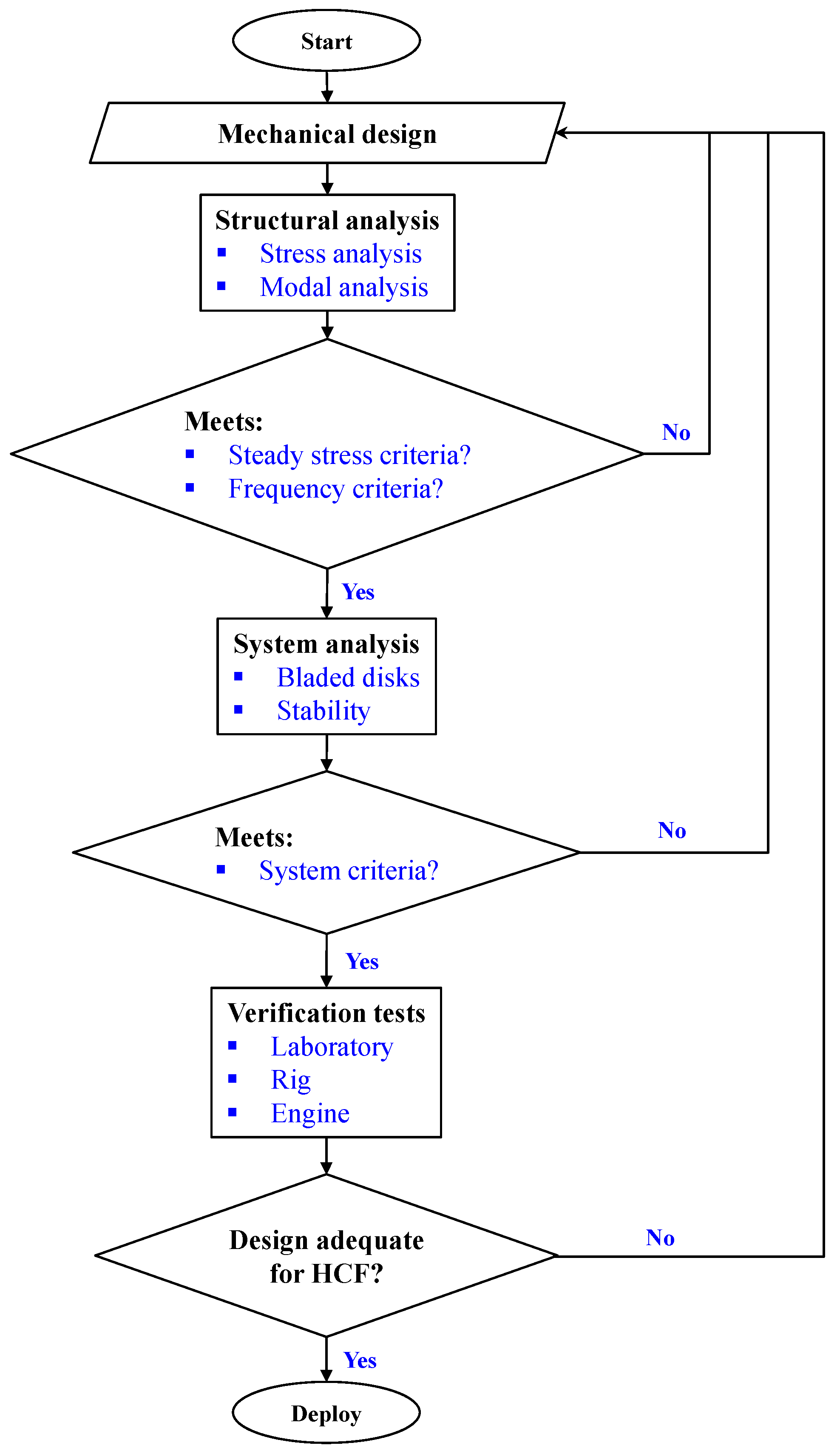
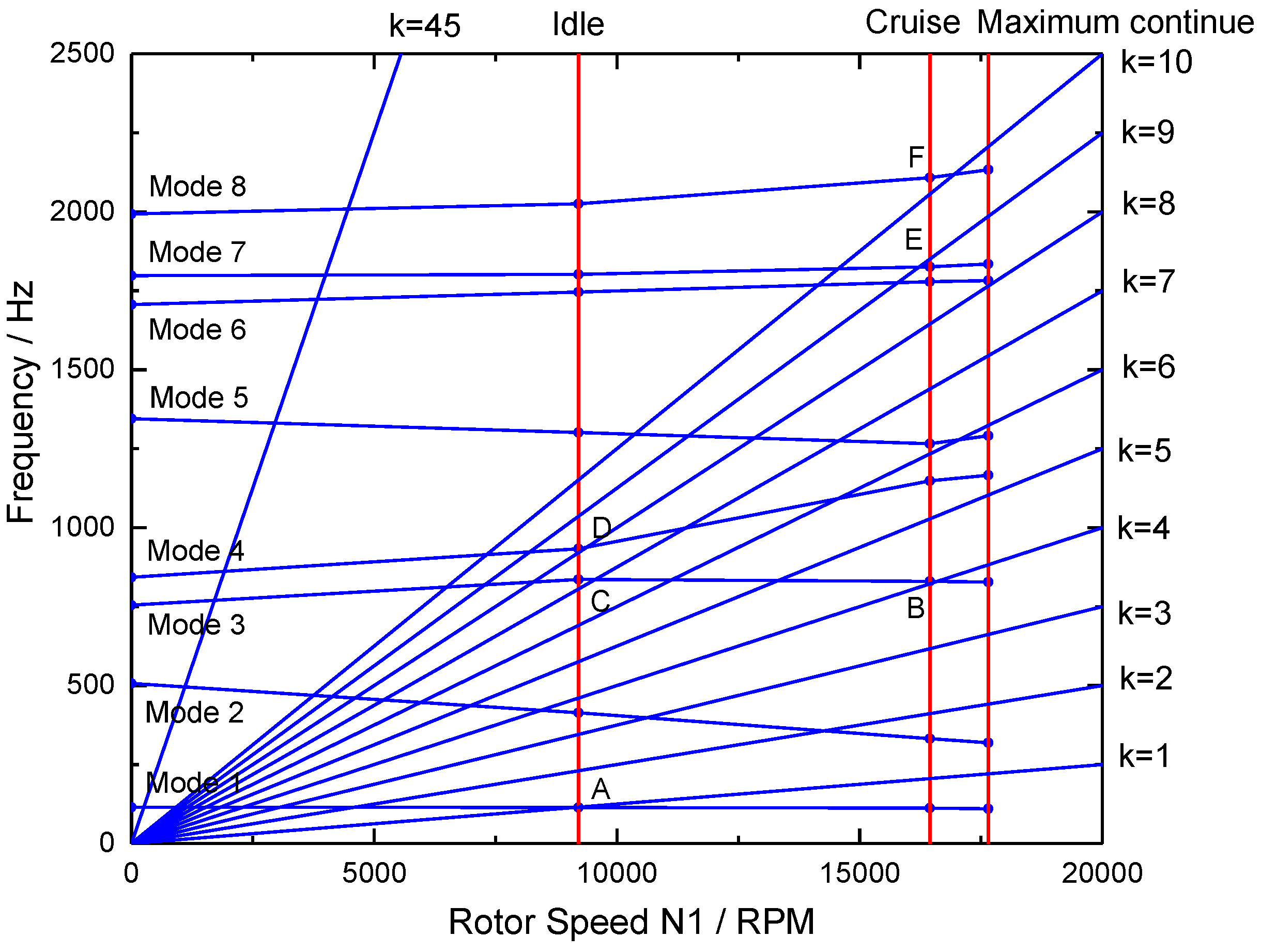
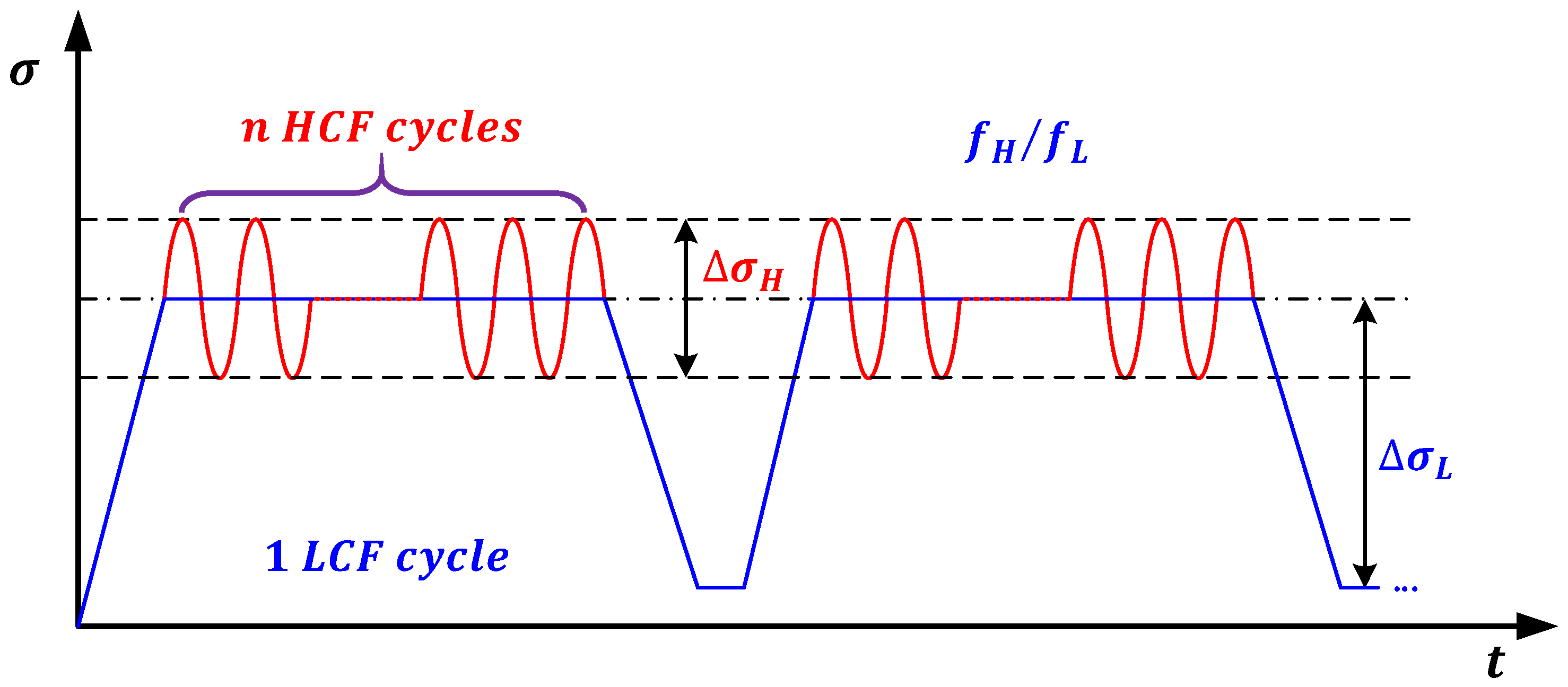
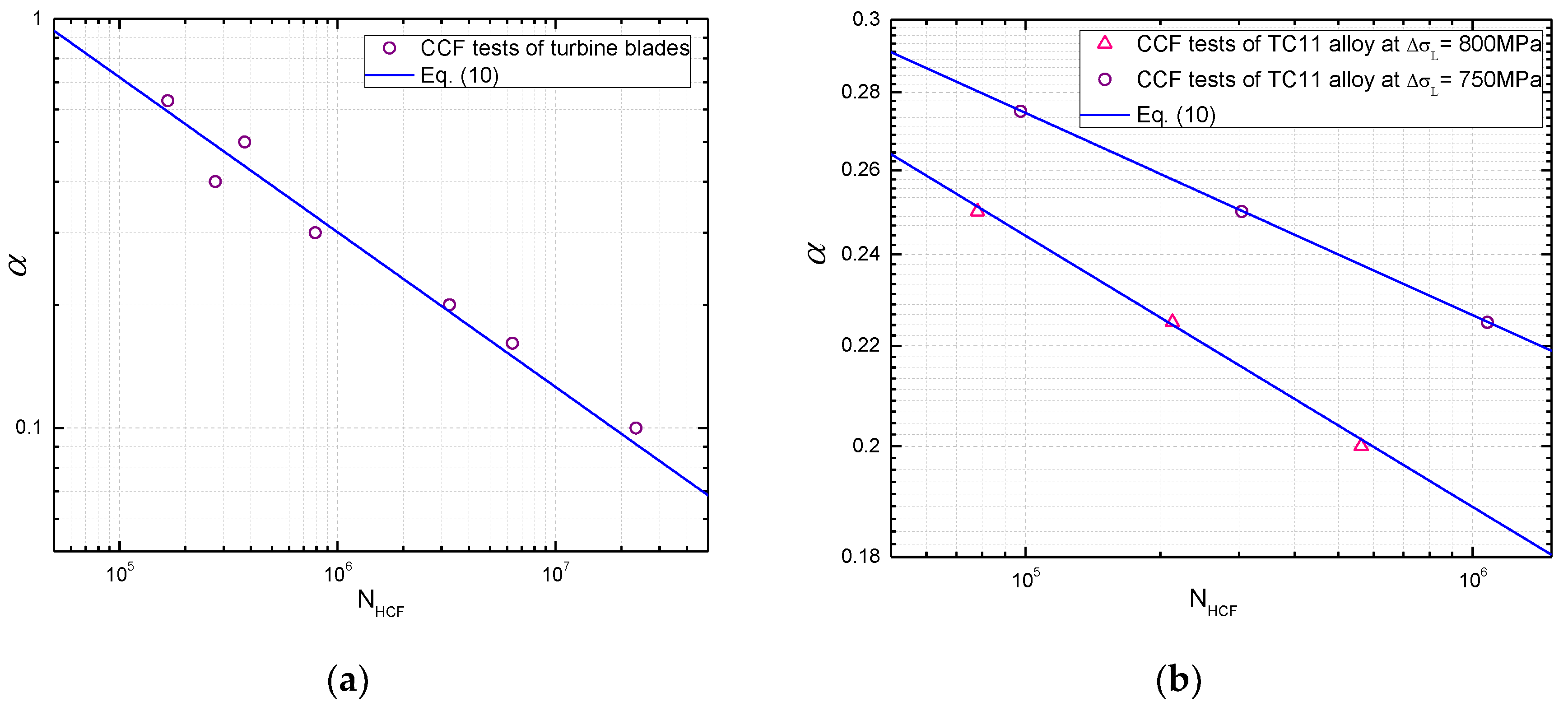
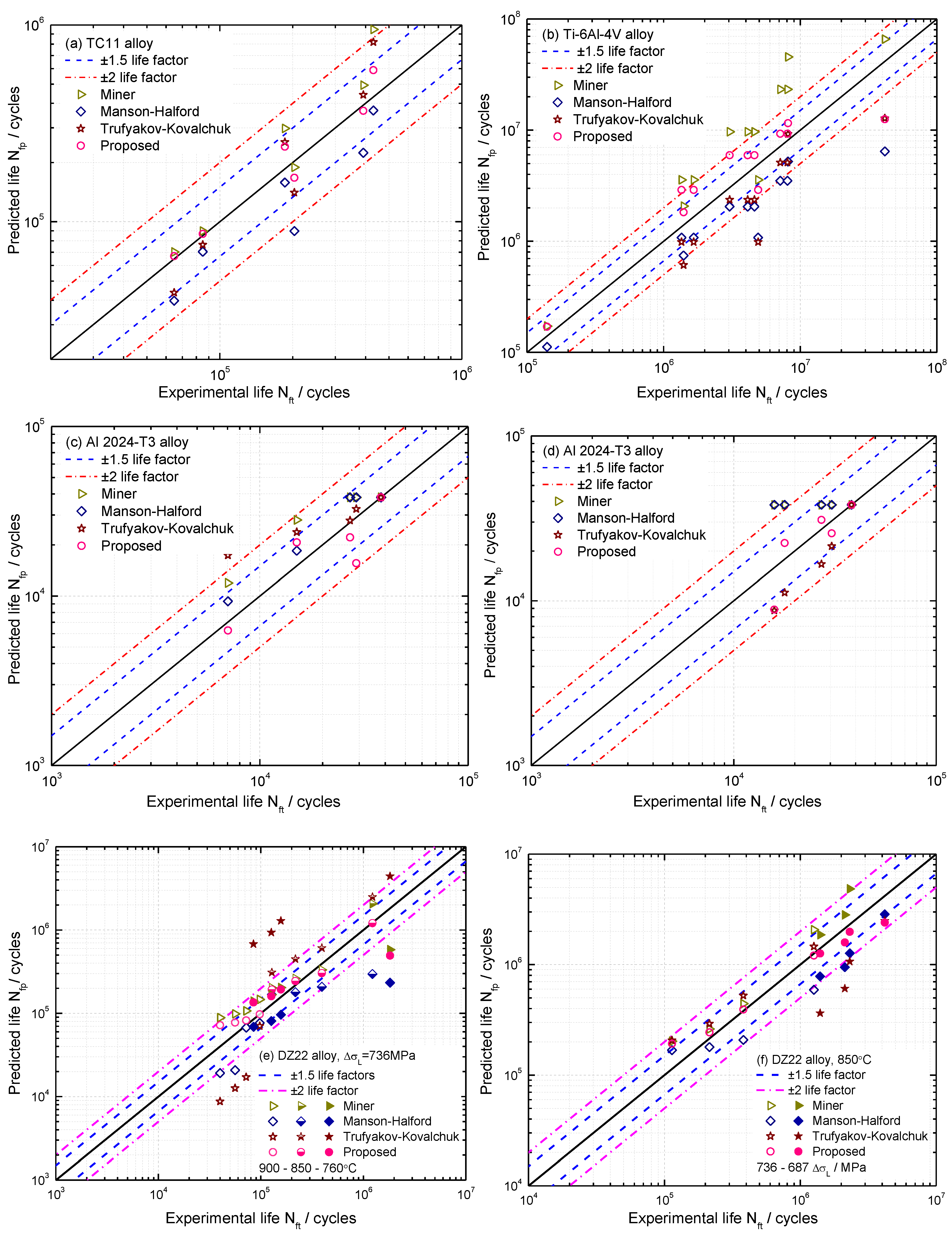

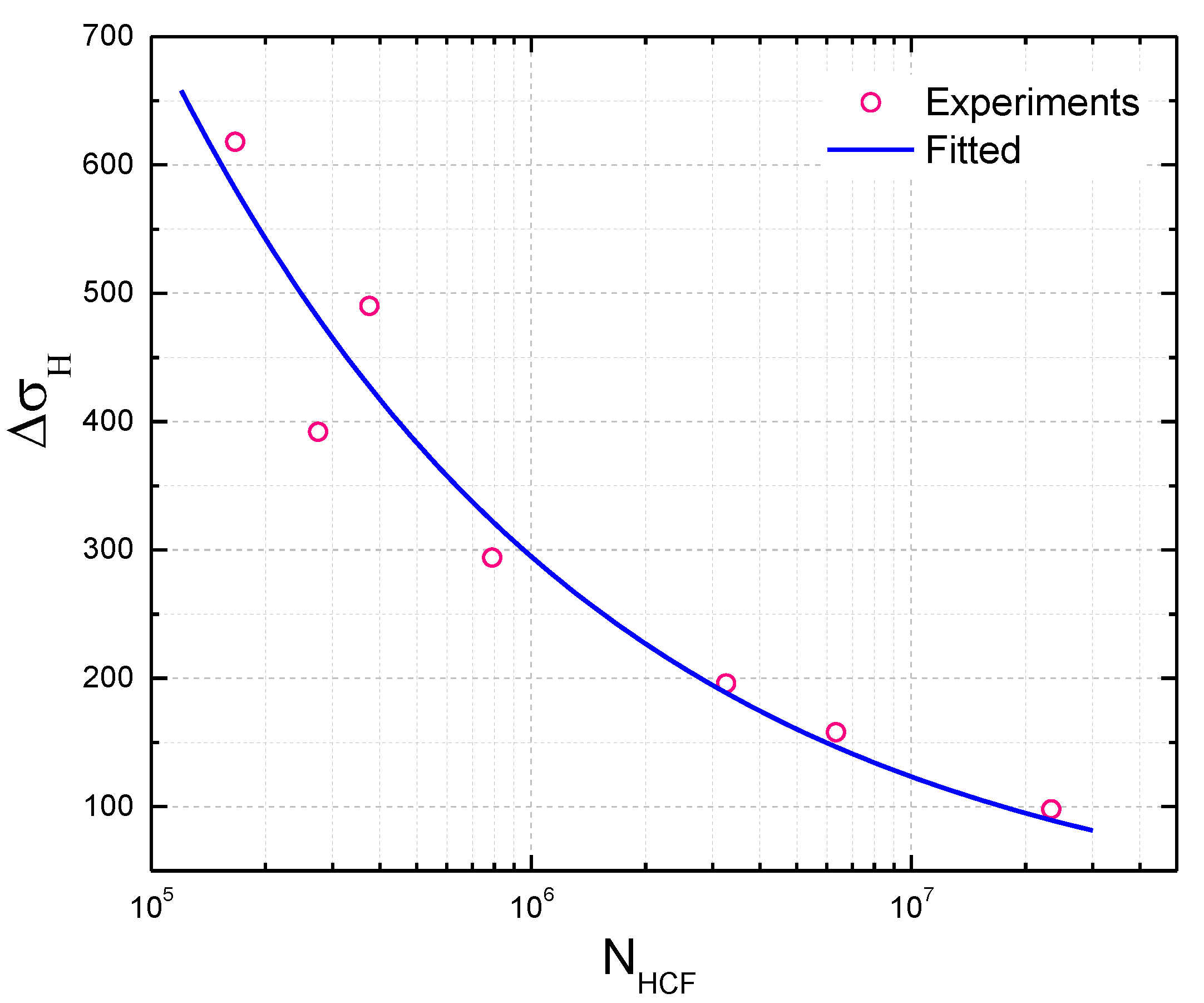

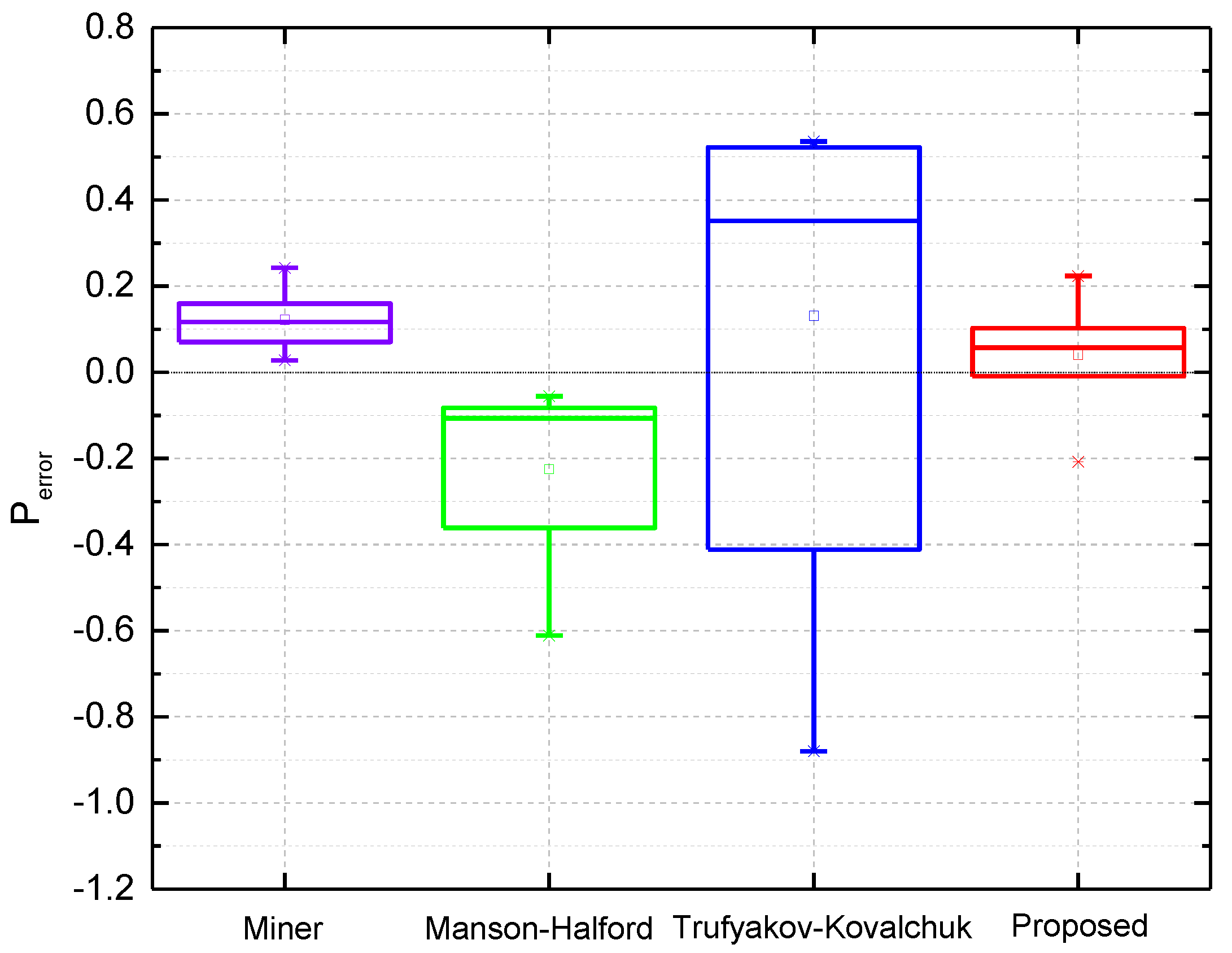
| No. | Amplitude of Vibration at Blade-Tip/mm | /MPa | CCF Life | |
|---|---|---|---|---|
| /Cycles | /103 Cycles | |||
| 1 | 0.5 | 98 | 4676 | 23380 |
| 2 | 0.8 | 158 | 1268 | 6340 |
| 3 | 1.0 | 196 | 652 | 3260 |
| 4 | 1.5 | 294 | 158 | 790 |
| 5 | 2.0 | 392 | 55 | 275 |
| 6 | 2.5 | 490 | 75 | 375 |
| 7 | 3.2 | 618 | 26 | 166.4 |
© 2017 by the authors. Licensee MDPI, Basel, Switzerland. This article is an open access article distributed under the terms and conditions of the Creative Commons Attribution (CC BY) license (http://creativecommons.org/licenses/by/4.0/).
Share and Cite
Zhu, S.-P.; Yue, P.; Yu, Z.-Y.; Wang, Q. A Combined High and Low Cycle Fatigue Model for Life Prediction of Turbine Blades. Materials 2017, 10, 698. https://doi.org/10.3390/ma10070698
Zhu S-P, Yue P, Yu Z-Y, Wang Q. A Combined High and Low Cycle Fatigue Model for Life Prediction of Turbine Blades. Materials. 2017; 10(7):698. https://doi.org/10.3390/ma10070698
Chicago/Turabian StyleZhu, Shun-Peng, Peng Yue, Zheng-Yong Yu, and Qingyuan Wang. 2017. "A Combined High and Low Cycle Fatigue Model for Life Prediction of Turbine Blades" Materials 10, no. 7: 698. https://doi.org/10.3390/ma10070698
APA StyleZhu, S. -P., Yue, P., Yu, Z. -Y., & Wang, Q. (2017). A Combined High and Low Cycle Fatigue Model for Life Prediction of Turbine Blades. Materials, 10(7), 698. https://doi.org/10.3390/ma10070698







